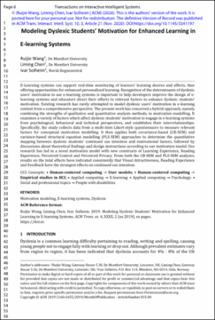| dc.description.abstract | E-Learning systems can support real-time monitoring of learners’ learning desires and effects, thus offering opportunities for enhanced personalized learning. Recognition of the determinants of dyslexic users’ motivation to use e-learning systems is important to help developers improve the design of e-learning systems and educators direct their efforts to relevant factors to enhance dyslexic students’ motivation. Existing research has rarely attempted to model dyslexic users’ motivation in e-learning context from a comprehensive perspective. The present work has conceived a hybrid approach, namely, combining the strengths of qualitative and quantitative analysis methods, to motivation modeling. It examines a variety of factors that affect dyslexic students’ motivation to engage in e-learning systems from psychological, behavioral, and technical perspectives, and establishes their interrelationships. Specifically, the study collects data from a multi-item Likert-style questionnaire to measure relevant factors for conceptual motivation modeling. It then applies both covariance-based (CB-SEM) and variance-based structural equation modeling (PLS-SEM) approaches to determine the quantitative mapping between dyslexic students’ continued use intention and motivational factors, followed by discussions about theoretical findings and design instructions according to our motivation model. Our research has led to a novel motivation model with new constructs of Learning Experience, Reading Experience, Perceived Control, and Perceived Privacy. From both the CB-SEM and PLS-SEM analyses, results on the total effects have indicated consistently that Visual Attractiveness, Reading Experience, and Feedback have the strongest effects on continued use intention. | |

